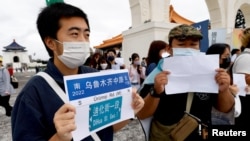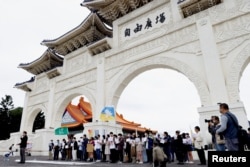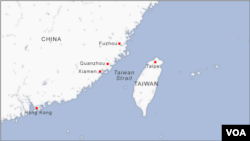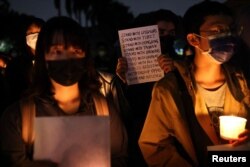For two weeks, small groups of Taiwanese have gathered in support of a wave of protests across China against the government’s strict COVID-19 restrictions and ongoing lockdowns in the largest movement of civil disobedience since the 1989 Tiananmen Square protests.
Rallies at Taipei’s Liberty Square and the campus of National Taiwan University have been attended by anywhere from 100-200 attendees, mainly students but also more politically minded members of the Democratic Progressive Party, or DPP, the pro-Taiwan independence activists, as well as those linked to Hong Kong, Tibet, and ethnic minority Uyghurs in far western China.
For organizers and attendees, the theme has focused largely on universal human rights and democracy in the midst of harsh restrictions aimed at getting China to “COVID Zero.” The focus of the rally Sunday at Liberty Square was on showing that “human rights are for every citizen of the world,” according to organizer and university student Angelina Lin.
The turnout for recent rallies has been similar to those for other recent issues like the war in Ukraine, but pales in comparison to the pro-Hong Kong solidarity marches that drew thousands of Taiwanese in the summer of 2019 as pro-democracy protests swept the city.
“Political parties and most notable activists have all expressed solidarity, even members from the [former ruling party] KMT, including former party chair Johnny Chiang and of course [President] Tsai Ing-wen. It is reminiscent to Hong Kong where all parties were expressing solidarity and support to the protests,” said Lev Nachman, an assistant professor at National Chengchi University in Taipei, who studies Taiwan’s political movements.
Translating support into on the ground rallies has been more complex, he said. “This party level of support does not necessarily trickle down into civil society’s support. Just like the Hong Kong protests, I expect support for the protests in Taiwan will vary overall, but I do expect a strong showing of support from at least some large swaths of civil society,” Nachman also said.
One reason for the more muted reaction, he said, may be due to the rise in Taiwanese identity since democratization that now sees China’s and Taiwan’s trajectories as independent despite deep cultural, linguistic, and historic ties.
Taiwan is formally known as the Republic of China, after the mainland government escaped to the island in the late 1940s at the end of the Chinese Civil War. For decades, Taipei claimed to represent all of China and even occupied its seat at the United Nations from 1945 to 1971, before it was booted in favor of the People’s Republic of China in Beijing.
During 1989’s Tiananmen Square student protests, Taiwan’s then-ruling Chinese Nationalist Party (KMT), in the last days of single-party rule and dogged by domestic pro-democracy protests, portrayed the Tiananmen demonstrations as a pan-Chinese struggle against communism.
This time, the official message of the KMT in now democratic Taiwan has been one of support for “freedom and human rights” and calls for Beijing to “respond to the will and needs of the people” according to official statements.
The change in tone is due to the change in Taiwan over the past 30 years, said Teresa Wright, a political science professor at California State University, Long Beach, as the island has transitioned from “quasi-authoritarian” to a full-fledged democracy.
“Back in 1989, the Chinese Communist Party was the enemy of the KMT so any unrest in China was kind of welcome and viewed as proof of the failure of communism and superiority of KMT-led system — implying the KMT-led political system by the KMT in Taiwan deserved to be the political leadership of all of China,” she said. These days the KMT is “trying to walk a very fine line” as its relationship with Beijing has evolved.
Distance from the protests in mainland China may also come from how information has been shared, with news of the recent demonstrations shared largely through covert social media posts that have managed to bypass China’s “Great Firewall” and end up on Twitter and Instagram.
Hong Kong’s 2019 protests, in contrast, were covered in real time by the international media and unrestricted. Even the Tiananmen protests in 1989 may have felt more immediate to Taiwanese, who were in the midst of a protest movement calling for political liberalization. Taiwanese students held a 2,000-person solidarity march and were famously connected by telephone to their Chinese counterparts at Tiananmen Square on the eve of June 3, 1989 — just a few hours before Chinese authorities opened fire on them.
Wen Lii, who spoke at a Liberty Square rally on Sunday and serves as director of the DPP’s Matsu Island office, said Taiwanese may have shifted much of their support for Chinese protesters from the pavement to the internet, he said, where the local media have heavily covered the anti-COVID Zero protests.
“I've noticed quite a lot of media coverage. I think people have taken note that these are the first large scale protests to take place in China on a national level for perhaps over three decades, since the 1989 student movements. So that in itself is significant,” Lii told VOA.
However limited, Taiwan’s response to the protests on the mainland was still welcomed by Leslie, a Chinese graduate student in Taipei who spoke to VOA on condition of anonymity at Sunday’s rally. Leslie said she attended rallies the last two weekends to show her support for her fellow citizens and see how Taiwanese felt about the protests.
“I just wanted to see why Taiwanese people still want to pay attention to this and their hopes. A lot of people don’t care as much, because I know the relationship between China and Taiwan is a little intense, so they don’t want to care about Chinese issues. I can understand that,” she said.
“But I always like people who care more. I have some friends who really supported this [movement] and they told me they were shocked, upset about the people who were arrested by the Chinese government. I was very moved.”










